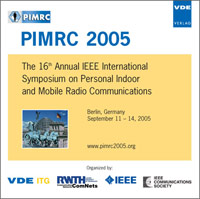Impact of Capture and Varying Transmit Power Levels on Saturation Throughput in IEEE 802.11
Konferenz: PIMRC 2005 - 16th Annual IEEE International Symposium on Personal Indoor and Mobile Radio Communications
11.09.2005 - 14.09.2005 in Berlin, Germany
Tagungsband: PIMRC 2005
Seiten: 6Sprache: EnglischTyp: PDF
Persönliche VDE-Mitglieder erhalten auf diesen Artikel 10% Rabatt
Autoren:
Vukovic, Ivan N. (Motorola Inc., 1441 W. Sure Dr., Arlington Heights, IL, 60004 USA)
Smavatkul, Natt (SAMART Comtech Co., Ltd., Software Park Building, Parkkred, Nonthaburi, Thailand)
Inhalt:
Multiple backlogged stations communicating with a central receiving node or Access Point using IEEE 802.11 MAC is analyzed. When packets are sent simultaneously often one of the packets can be successfully received by the Access Point due to power capture effect. Several schemes for assigning transmit power level to each station are investigated along with two capture models. We apply a well know saturation throughput methodology developed by Bianchi which was recently simplified allowing schemes other than Binary Exponential Backoff to be analyzed. With stations in different radio conditions the user population is not homogeneous and the collision probability is not fixed. Two schemes are investigated in which each station is either assigned a fixed power level from a set of k levels or randomly chooses a power level for each transmission from the same set. We show that power capture improves performance of 802.11 in the basic mode for each scheme. We also calculate individual user throughput and show that significant fairness imbalance arises with fixed power assignments. We also provide an upper bound for the throughput assuming perfect knowledge of the number of colliding stations.


